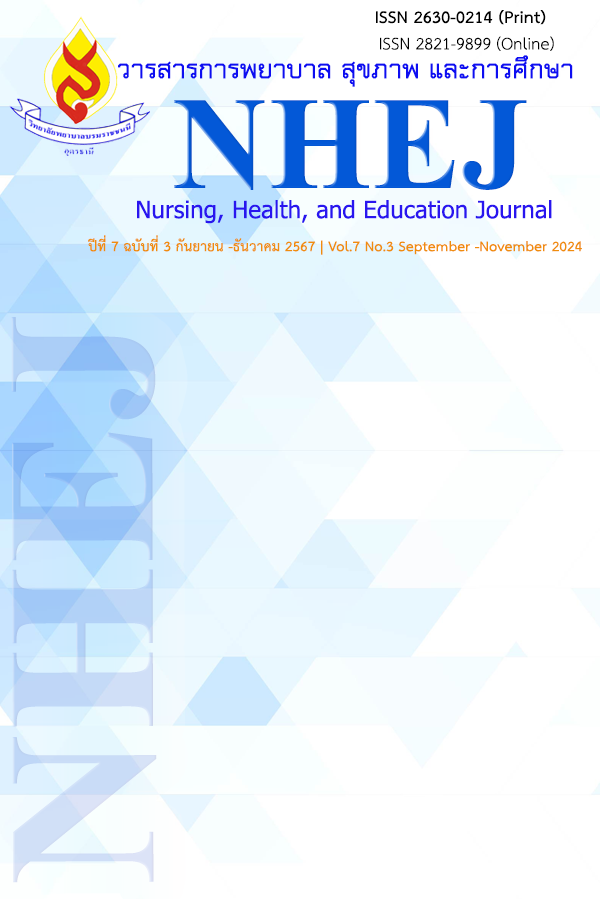ประสิทธิผลของการใช้แนวปฏิบัติการพยาบาลในการดูแลผู้ป่วยโรคหลอดเลือดสมองแตกที่ได้รับการรักษาแบบไม่ผ่าตัด เข้ารับการรักษาในหอผู้ป่วยวิกฤตศัลยกรรมประสาท
คำสำคัญ:
Nursing practice guidelines, Hemorrhagic stroke, Systolic blood pressure, Increased intracranial pressureบทคัดย่อ
งานวิจัยนี้มีวัตถุประสงค์เพื่อพัฒนาและศึกษาประสิทธิผลของแนวปฏิบัติการพยาบาลในการดูแลผู้ป่วยโรคหลอดเลือดสมองแตก ที่ได้รับการรักษาแบบไม่ผ่าตัด เข้ารับการรักษาที่หอผู้ป่วยวิกฤตศัลยกรรมประสาท โรงพยาบาลนพรัตนราชธานี กลุ่มตัวอย่างจำนวน 90 ราย แบ่งเป็นกลุ่มควบคุม 45 คน และกลุ่มทดลอง 45 คน เครื่องมือที่ใช้ดำเนินงานวิจัยคือ แนวปฏิบัติการพยาบาลในการดูแลผู้ป่วยโรคหลอดเลือดสมองแตกที่ได้รับการรักษาแบบไม่ผ่าตัด เครื่องมือที่ใช้ในการเก็บรวบรวมข้อมูลสำหรับผู้ป่วย ประกอบด้วย 4 ส่วน ได้แก่ แบบบันทึกข้อมูลกลุ่มตัวอย่าง แบบคัดกรองระดับความรุนแรงของโรคหลอดเลือดสมองแตก แบบประเมินแบบประเมินระดับความพิการหลังเกิดโรคหลอดเลือดสมอง และแบบบันทึกการเกิดภาวะความดันในกะโหลกศีรษะสูง วิเคราะห์ข้อมูลโดยใช้สถิติเชิงพรรณนา Chi-squared test, Fisher's exact test, Independent t-test, Repeated measure ANOVA ผลการวิจัยพบว่าหลังใช้แนวปฏิบัติการพยาบาลสามารถลดความดันโลหิตซีสโตลิก หลังเข้ารับการรักษา 1 ชั่วโมง และ 24ชั่วโมงอย่างมีนัยสำคัญทางสถิติ อุบัติการณ์การเกิดภาวะความดันในกะโหลกศีรษะสูงและอัตราการเสียชีวิตลดลงอย่างมีนัยสำคัญทางสถิติ ผลการศึกษาแสดงให้เห็นว่าแนวปฏิบัติการพยาบาลที่พัฒนาขึ้นมีประสิทธิผลในการควบคุมความดันโลหิตและลดภาวะแทรกซ้อนที่สำคัญในผู้ป่วยโรคหลอดเลือดสมองแตก สามารถนำไปประยุกต์ใช้ในการดูแลผู้ป่วยกลุ่มนี้ในหอผู้ป่วยวิกฤตเพื่อพัฒนาคุณภาพการพยาบาลและผลลัพธ์ทางคลินิกต่อไป
เอกสารอ้างอิง
Unnithan AKA, Das JM, Mehta P. Hemorrhagic Stroke [Internet]. Treasure Island (FL): StatPearls
Publishing; 2023 [cited 2024 Nov 25]. Available from: https://www.ncbi.nlm.nih.gov/books/NBK559173/
Nisar T, Alchaki A, Hillen M. Validation of ICH score in a large urban population. Clin Neurol
Neurosurg. 2018;174:36-39.
Rangsawat S. Factors affecting 30-day mortality rate in patients with primary intracerebral
hemorrhage at Mukdahan Hospital. Nakhon Phanom Hosp J. 2021;8(2):28-43. In Thai.
Magid-Bernstein J, Girard R, Polster S, Srinath A, Romanos S, Awad IA, et al. Cerebral
Hemorrhage: Pathophysiology, Treatment, and Future Directions. Circ Res. 2022;130(8):1204-29.
An SJ, Kim TJ, Yoon BW. Epidemiology, Risk Factors, and Clinical Features of Intracerebral
Hemorrhage: An Update. J Stroke. 2017;19(1):3-10.
Tiamkao S. Stroke situation in Thailand. J Thai Neurol. 2021;37(4):54-60. In Thai.
Hemphill JC 3rd, Greenberg SM, Anderson CS, Becker K, Bendok BR, Cushman M, et al.
Guidelines for the Management of Spontaneous Intracerebral Hemorrhage: A Guideline for
Healthcare Professionals From the American Heart Association/American Stroke Association.
Stroke. 2015;46(7):2032-60.
Frontera JA, Lewin JJ 3rd, Rabinstein AA, Aisiku IP, Alexandrov AW, Cook AM, et al. Guideline
for Reversal of Antithrombotics in Intracranial Hemorrhage: A Statement for Healthcare
Professionals from the Neurocritical Care Society and Society of Critical Care Medicine.
Neurocrit Care. 2016;24(1):6-46.
Rojana S. Development of nursing care model for hemorrhagic stroke patients with
hypertension. Thai J Cardiovasc Thorac Nurs. 2020;31(2):206-21. In Thai.
Siripraphaphon S, Panprasert S, Ditprae S. Development of care system for hemorrhagic
stroke patients with hypertension at Somdejphraphutthalertla Hospital. J Health Sci.
;31(2):s353-64. In Thai.
Saeng-in P, Thongmee P, Plueynongkae S, Petsanghan P, Hanlue K, Saenyamool S.
Development of nursing practice guidelines for hemorrhagic stroke patients in neurosurgical
intensive care unit, Roi Et Hospital. J Nurs Health Care. 2024;42(3):e272542. In Thai.
Soukup SM. The Center for Advanced Nursing Practice evidence-based practice model:
promoting the scholarship of practice. Nurs Clin North Am. 2000;35(2):301-9.
Cohen J. Statistical power analysis for the behavior sciences. 2nd ed. New York: Lawrence
Erlbaum Associates; 1988.
Hemphill JC, Bonovich DC, Besmertis L, Manley GT, Johnston SC. The ICH Score: A Simple,
Reliable Grading Scale for Intracerebral Hemorrhage. Stroke. 2001;32(4):891-7.
Rankin J. Cerebral vascular accidents in patients over the age of 60. II. Prognosis. Scott Med
J. 1957;2(5):200-15.
Joanna Briggs Institute. JBI EBP Database Guide [Internet]. 2024 [cited 2024 Nov 25]. Available
from: https://ospguides.ovid.com/OSPguides/jbidb.htm
Neurological Institute of Thailand. Clinical practice guideline for hemorrhagic stroke: Care
map for hemorrhagic stroke. Bangkok: Thana Press; 2019. In Thai.
Aldhaeefi M, Badreldin HA, Alsuwayyid F, Alqahtani T, Alshaya O, Al Yami MS, et al. Practical
Guide for Anticoagulant and Antiplatelet Reversal in Clinical Practice. Pharmacy (Basel).
;11(1):34.
Teo KC, Keins S, Abramson JR, Leung WCY, Leung IYH, Wong YK, et al. Blood Pressure
Control Targets and Risk of Cardiovascular and Cerebrovascular Events After Intracerebral
Hemorrhage. Stroke. 2023;54(1):78-86.
Kuramatsu JB, Gerner ST, Schellinger PD, Glahn J, Endres M, Sobesky J, et al. Anticoagulant
reversal, blood pressure levels, and anticoagulant resumption in patients with
anticoagulation-related intracerebral hemorrhage. JAMA. 2015;313(8):824-36.
Law ZK, Appleton JP, Bath PM, Sprigg N. Management of acute intracerebral haemorrhage –
an update. Clin Med (Lond). 2017;17(2):166-72.
Shoamanesh A, Lindsay MP, Castellucci LA, Cayley A, Crowther M, de Wit K, et al. Canadian
stroke best practice recommendations: Management of Spontaneous Intracerebral
Hemorrhage, 7th Edition Update 2020. Int J Stroke. 2021;16(3):321-41.
Manchi MR, Venkatachalam AM, Atem FD, Stone S, Mathews AA, Abraham AM, et al. Effect of
inpatient rehabilitation facility care on ninety day modified Rankin score in ischemic stroke
patients. J Stroke Cerebrovasc Dis. 2023;32(6):107109.
Singkwang K. Development of clinical practice guidelines for initial assessment of increased
intracranial pressure warning signs in post brain tumor surgery patients. Buddhachinaraj
Med J. 2020;37(2):136-48. In Thai.
ดาวน์โหลด
เผยแพร่แล้ว
รูปแบบการอ้างอิง
ฉบับ
ประเภทบทความ
สัญญาอนุญาต
ลิขสิทธิ์ (c) 2024 วิทยาลัยพยาบาลบรมราชชนนีอุดรธานี

อนุญาตภายใต้เงื่อนไข Creative Commons Attribution-NonCommercial-NoDerivatives 4.0 International License.




